I have spent around $250,000 in real estate marketing. In my first 3.5 years, I built a team of real estate agents that closed 550+ transactions and acquired 74 rental units.
At least $50,000 of the $250k spent was a waste, and this post is to teach you:
Everything I wish I had known before marketing my real estate business
A 5,000ft view of Real Estate Marketing so you can understand marketing concepts
Table of Contents:
- Chapter 1: Sales Funnel
- Chapter 2: Demand Generation vs. Demand Capture
- Chapter 3: ROI and ROAS
- Chapter 4: Cash Conversion Cycle
- Chapter 5: Cold Audience vs. Warm Audience
- Chapter 6: Choosing Your Marketing Channel
- Chapter 7: Digital World
- Chapter 8: Lead Magnets
- Chapter 9: Marketing Efficiency
- Chapter 10: Buyers or Sellers?
- Concluding Real Estate Marketing
Chapter 1: Sales Funnel
Do you remember those big funnels in grocery stores where you could roll a coin down the ramp to donate money? At first, the coin would slowly roll around the top and you could easily grab it. When it got to the middle, it was moving a little faster but you could still grab it.
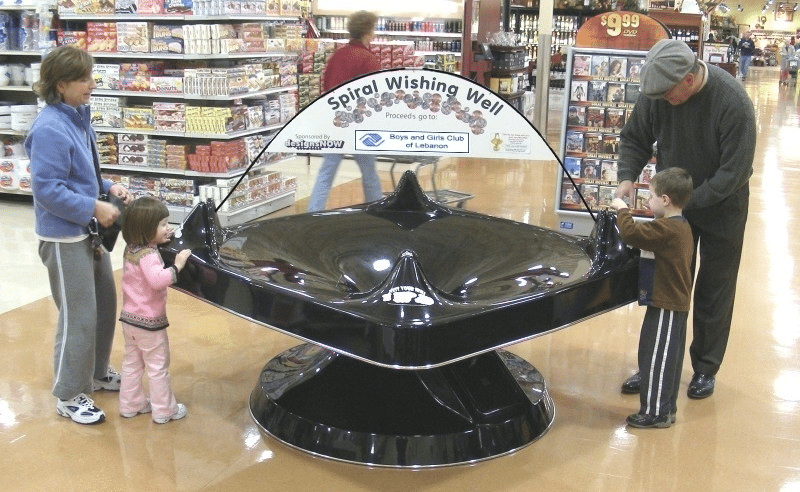
At the bottom, that coin was spinning around the funnel so fast it was tough to grab. If you touched it, it was likely going in the hole.
Now imagine leads for your business are the coins, and the funnel is the journey they go on. Under the funnel is a bucket of money. Whatever the coin touches last before it goes in the bucket, is who helped them through the transaction. You have 2 options:
Let the coin take the funnel (another agent)… OR
Grab the coin, and drop it right in the bucket
What does this have to do with real estate marketing?
Marketing is your ability to locate the coins in the funnel, and persuasion is your ability to snatch those coins.
A big difference is that your ‘client coins’ have emotions and teeth. They will bite you if you try to grab them when they don’t want to be grabbed.
This is why the best salespeople don’t let their clients feel like they’re being sold.
It’s your job to grab your ‘client coins’ from the funnel, cradle them, and sing them lullabies all the way to the closing table.
Let’s split your “client coins” journey into 5 stages… and try not to waste your time with the first 2 stages.
Stage 1: Unaware
Remember when you’d drop the coin down the ramp? When it first hit the funnel, it spun around the top, practically peaking over the edges.
This is the same for the people in the home-buying or selling process. These people aren’t eligible to buy a house, or don’t know they could.
This stage of the funnel is not a good use of your marketing efforts.
Stage 2: Aware
These people are a little further down the funnel and do have a line of sight to the bucket down below. They know it’s possible, but they don’t want to buy or sell a house…
Too cool for school.
Stage 3: Consideration
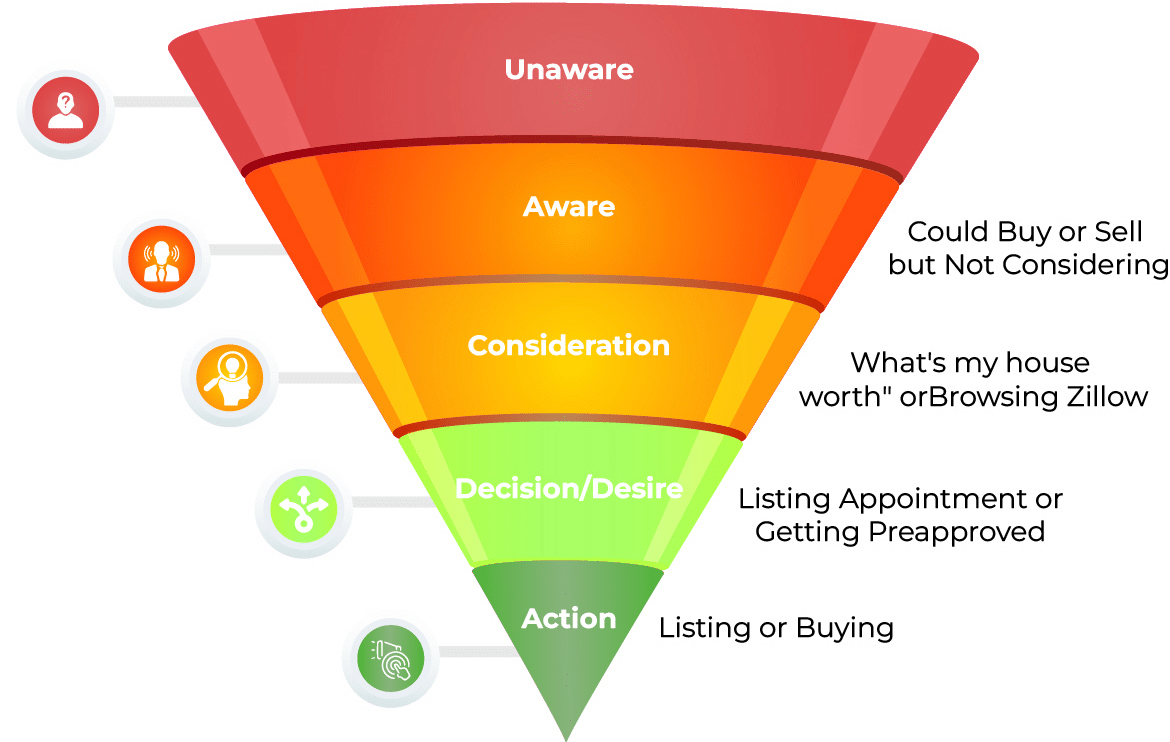
These ‘client coins’ are in the middle of the funnel (MOFU). They not only see the possibility of buying or selling a house; their interest is triggered.
If they are considering selling, they’re probably wondering ‘What is my house worth?’ or ‘Is it a good time to sell a house?’
If they are considering buying, they might be browsing Zillow or wondering if now is a good time to buy a house.
So, if you spoke to 1,000 people in the ‘aware’ stage and 1,000 people in the ‘consideration’ stage, which one do you think would produce more closings?
Stage 4: Decision
Past considering, these people have decided to buy or sell a home. They are either getting pre-approved or waiting for a specific date and time to start taking action…
I’ll ask again: if you spoke to 1,000 people in the ‘consideration’ stage and 1,000 people in the ‘decision’ stage, which one do you think would produce more closings?
Stage 5: Action
The hottest leads you can get are the buyers and sellers who are ready to start making n’ taking offers. It’s rare that you will find someone in this stage but a good example is a lead Christian Koenig got from Zillow. They were cash buyers.
From the time the lead came in to his buyer closing on the house, it took 5 days.
So, how do you find leads DEEP in the funnel?
Chapter 2: Demand Generation vs. Demand Capture
If you were ready to sell your house but didn’t know an agent, what would you do?
I’d go to Google and search for a real estate agent or something like ‘How do I sell my house?’

In this case, the demand for your services is already there. You just gotta get in front of the right people. This is called ‘demand capture’ because you are capturing the demand that already exists.
But it’s not just when people are ready to sign the listing agreement… It applies throughout the entire sales funnel. So, you can use demand capture marketing for your real estate business all the way from the ‘consideration’ stage to the ‘action’ stage.
For example: Fayetteville, NC is a military town with traditionally very little appreciation. Military members would use their VA loan which is 0% down and usually couldn’t afford to sell their house after 3 years.
Since it was well known in that area, people considering selling would be asking things like, ‘Can I sell my house’ or ‘Will I have to pay to sell my house?’ Both of these phrases indicate the consideration stage.
On the other hand, you have people who are at different stages of the funnel but not actively seeking solutions. For example…
I spent around $35,000 on Facebook ads in 2022. Those ads consisted of people who wanted to sell off-market, without a realtor, or ‘sell your house fast’. They weren’t actively searching for it, but we were getting in front of them to tell them it’s SO much easier to sell your house to us than on the market with an agent.
There was absolutely no risk in getting the offer.
I was generating the demand for my services.
As with ‘demand capture’, you can generate demand for your real estate business at any stage in the funnel… But let me ask you this:
Would you rather work with someone who was actively seeking your services or someone who stumbled upon it?
Personally, the people who are proactive are the people I most enjoy working with, but to each their own.
The biggest difference between the two is that there is a limited supply of demand-capture marketing, whereas with demand generation is much more scalable.
Chapter 3: ROI and ROAS
Realtors brag about not spending money on marketing, yet they happily pay hefty referral fees… To me, it’s an illogical train of thought… “I’m proud I don’t have to front any money and my source of revenue is reliant on other people.”
What if you could pay less than a referral fee and generate as much business as you want?
Marketing might be classified as an expense on a profit and loss statement, but in my eyes it’s considered an investment. Investments are supposed to yield returns…

Keep in mind, it’s a high-risk investment but could also 5x your money in under 1 year. So, how do you calculate your return on investment (ROI)?
ROI = ((Money earned – Money spent) / (Money Spent)) x 100%
Or more simply, profits divided by marketing spent.
This will give you a percentage gained on your investment
What is ROAS
In the digital marketing world, a more common term used is return on ad spend (ROAS). Instead of calculating the profit, they just use the revenue… People usually leave it in decimal form as well. for example:
ROAS = Money earned / money spent
If it’s 1.0 or over, you made money!! If it’s below 1, you lost money.
Chapter 4: Cash Conversion Cycle
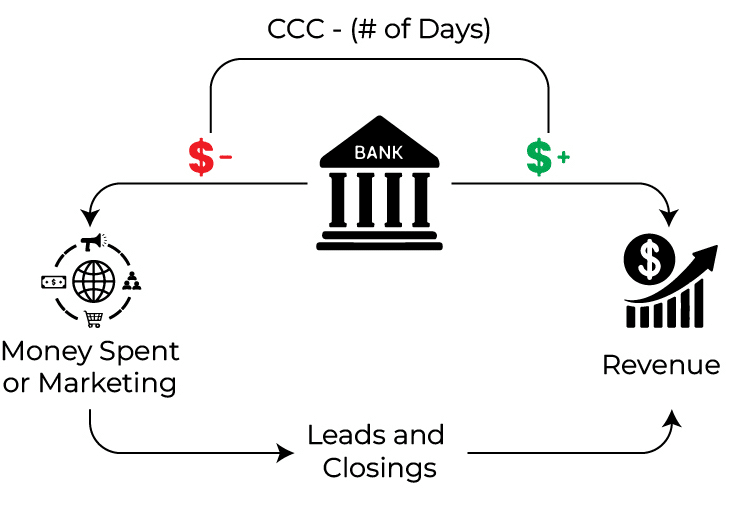
When I first started spending what I considered a TON of money on real estate marketing, I didn’t know what I was really getting myself into. I spent around $6k on a drop of direct mail which was around 5,000 letters. Less than 0.7% of people responded to my letter and it stressed me out.
I ended up generating less than 10 leads… So I tried again. This time I sent postcards and I only got 1 response out of 2000 postcards.
I felt defeated… I ended up spending around $10k on direct mail and after 3 months, it resulted in nothing. 7 months later I closed my first deal and made that $10,000 back. Then 6 months after that, I closed another deal and made a little over $30,000 on that deal.
After more than a year, I quadrupled my money spent on direct mail… That’s a long time and if I really knew it was going to take that long, I would’ve done something else.
Have you considered how quickly you’d see an ROI on your marketing dollars?
Cash conversion cycle is the length of time it takes you to convert leads once they come into your CRM.
For example: Let’s say you’re running YouTube ads and the average lead closes 120 days after it came into your CRM. That’s your cash conversion cycle!
A huge mistake I made early on was not projecting my cash conversion cycle correctly…
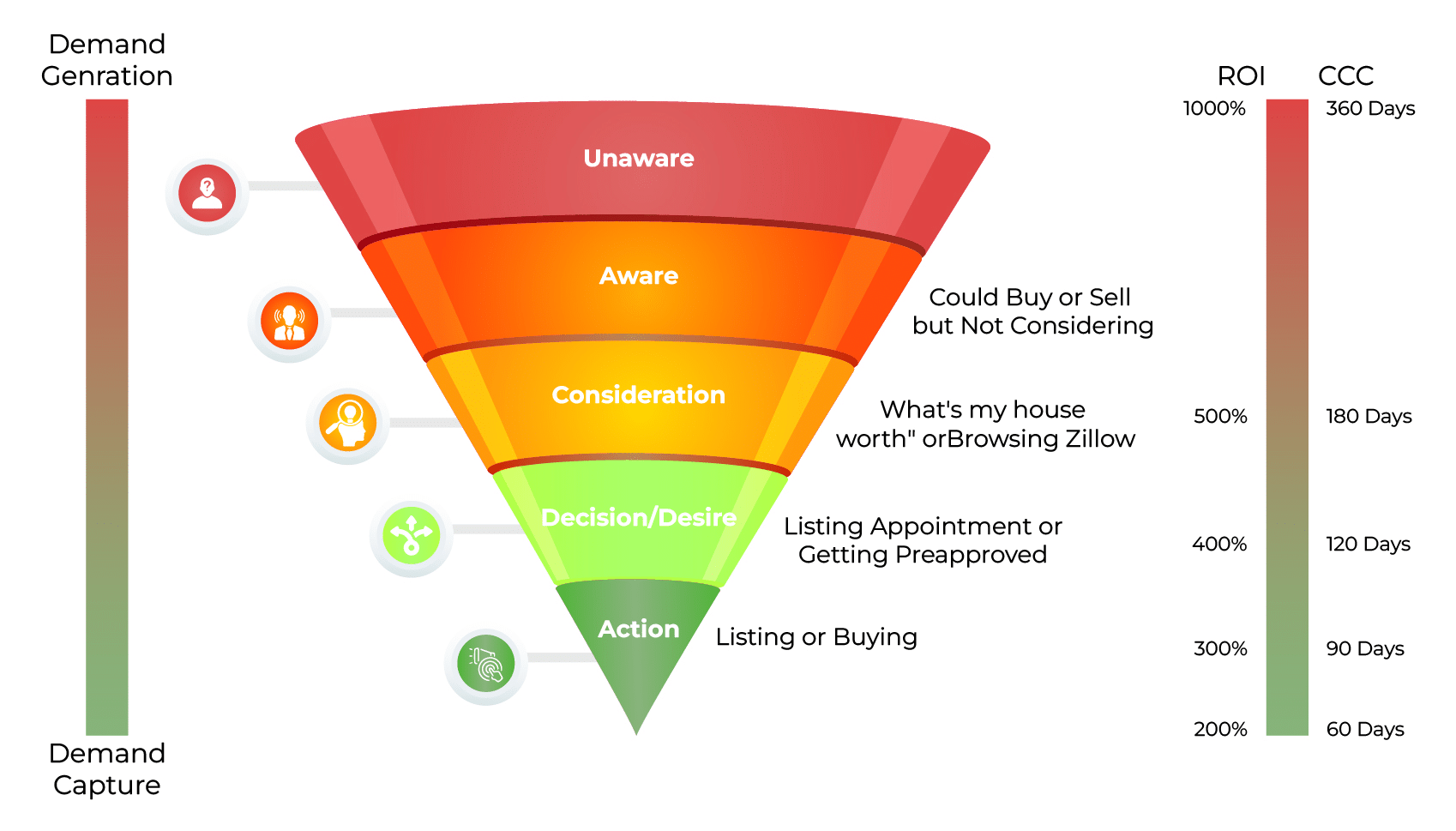
Marketing Stamina
Let’s say you magically KNOW your cash conversion cycle is going to be 90 days when you start a marketing channel. In theory, you will have all of your money back and a good return by the end of that 90-day period… Which is almost never the case in business.
Plus, there is always a learning curve for a new marketing channel.
Delays happen and deals blow up… Depending on your real estate marketing strategy, you should budget as if your cash conversion cycle is double, or if you’re a newer agent, triple.
Heads up, most marketing channels take 3-6 months.
Here are some examples from people who market heavily:
Bill Sohl spends $300k+ per year on direct mail and says to plan on a full year of mailing every 1.5 months to get your direct mail campaign to a positive ROI
Jason Boice is a real estate agent in CT and has been spending $1,000 per month on Zillow leads for over a year. He typically closes a Zillow lead in 4 months… Some actually only take 1 month and others can take over 1 year.
If you find a lead source with a CCC that is under 120 days. Try to own that machine and scale your ad spend as long as you’re still getting an ROI.
Chapter 5: Cold Audience vs. Warm Audience
Those of you who have been around for a while know it is SO much easier to close deals with people who already know, like, and trust you. Since they already know and like you, they are a ‘warmed up to you’.
Now, if you get a lead from Zillow or Google PPC, chances are they have no idea who you are.
Would you rather work with someone who has watched every one of your Instagram stories for the past 4 months, or someone who has never even heard your name?
So… How can you turn your cold leads into fans?
Warm Up Your Cold Audience
You can call all of your leads. This builds a more personal connection and can lead to more closings. But, what I don’t like is you can never call 2 of your leads at once.
We live in 2023. People don’t like being interrupted throughout their day… and almost everyone is on a couple of social media platforms. Would you rather call 250 people per day, or make a single social media post?
By having an engaging social media presence, you are able to leverage your time and relationships.
Use your different social media accounts to build credibility and trust with your audience. Someone I think highly of, and my co-host on The Agent Goldmine is an expert at social media marketing. You can check out my interview with her here:
Chapter 6: Choosing Your Marketing Channel
If you search for ‘real estate marketing strategies’, chances are you stumbled upon multiple websites and silly YouTubers saying, ‘Get a real estate website’.
This is the worst advice I’ve ever heard… As of January 1, 2023, there are 1,986,154,062 websites. More importantly, 90.63% of those websites get NO traffic and only 0.21% get more than 1,000 visits daily. You won’t get any leads or revenue without website visitors… This is what I see way too often with agents’ websites.
According to Alex Hormozi’s new book, $100M Leads, there are only 4 ways for you to get leads.
Outreach is as close to free real estate leads as you’re going to get.
Cold outreach (1-1, people who don’t know you)
Warm outreach (1-1, people who do know you)
Posting free content (1-Many, know you, low-cost, high effort)
Running paid ads (1-Many, don’t know you, High-cost, low effort)
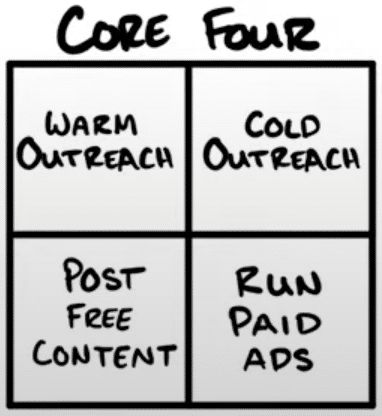
I believe everyone should post free content at least a couple times per week… This helps build trust with your audience… It also grows your audience.
Do you have to? No.
But choose one of these categories, and a specific platform, and master that ONE. THING.
If you’re in a big enough market, one channel should bring you enough business to get your first couple employees and a buyers agent.
Chapter 7: Digital World
As time goes on and information becomes more and more accessible, the real estate industry is becoming more and more digital. You can do a 3D online ‘walkthrough’ with 4k quality. So, if your real estate marketing plan doesn’t evolve with the rest of society, you will struggle to grow.
Do not mistake what I’m saying… I fully believe that you can build a successful real estate sales business with your personal connections. But if you want to grow a business that does hundreds, or thousands of transactions per year, digital marketing is one of the easiest to scale.
The 2 reasons digital real estate marketing is great:
Great content generates leads and builds an audience
Once a paid ad works, to scale the results you scale ad-spend
For example…
There was once a time when I had less than 1,000 followers on Instagram. When I posted, I’d be lucky to get 1,000 impressions… I have not been active on Instagram for a while… but I still have a little over 7,000 followers. So when I occasionally make a post, I don’t get less than 1,000 impressions, and sometimes it’s over 10,000 impressions.
Chapter 8: Lead Magnets
In the words of Alex Hormozi, a lead magnet is the complete solution to a narrow problem. For example:
A current common problem for real estate agents is high interest rates. So, do you have a solution for high interest rates? If you do, potential home buyers are going fight over it.
In the digital world, a lead magnet is normally an opt-in page where the lead will fill out a form with their contact info. Sometimes it includes information about what they are looking for like size of the house, bedrooms, bathrooms… You get the idea. Here’s a screenshot of a squeeze page, lead capture page, whatever you want to call it.
Between this page and the ad that runs traffic to it, it generates seller leads at around $38/lead.
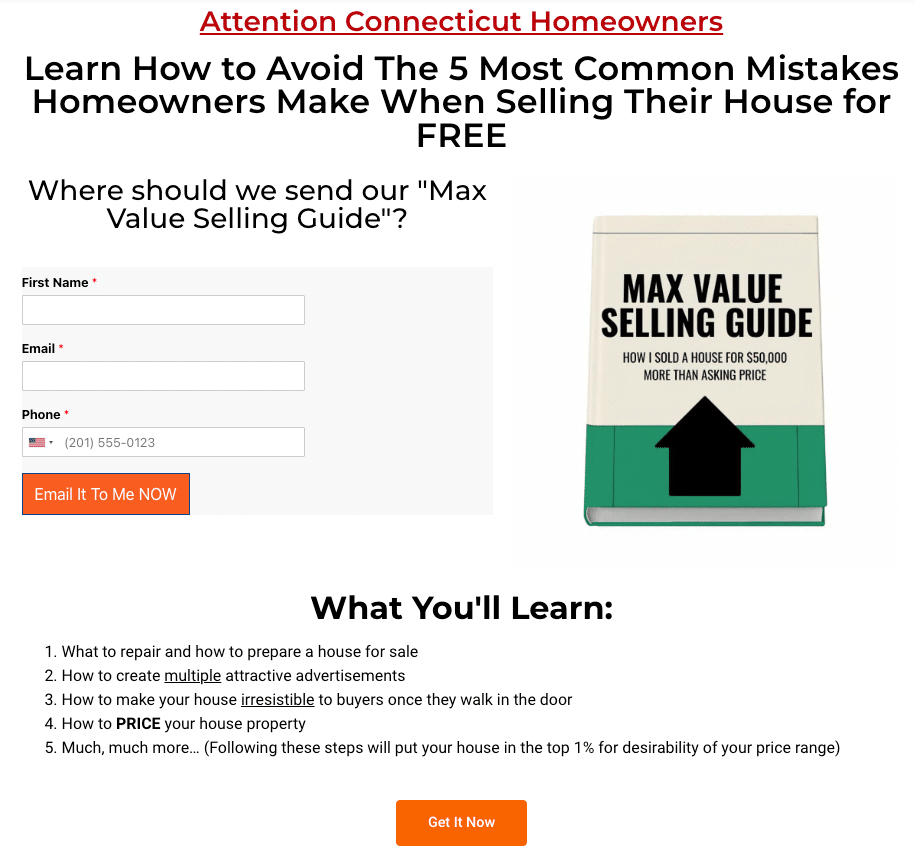
Once you have their info, you send them what they thought they were filling out a form for. The better quality product you send them, the more likely they are going to become a client of yours.
So, if your lead magnet is solving the high-interest rate crisis, make sure they learn how to fix their problem. You want to build trust and get them to like you.
It also helps to include past clients’ testimonials. They don’t need to look like a high-quality film, they need to look real. Even if it’s a shaky selfie video of you talking with a previous client, and they say working with you was amazing… That’s much better than a TV commercial that looks completely staged.
Chapter 9: Marketing Efficiency
So, by now you should have an idea of how you want to market your real estate business… The next big concern is measuring how well your marketing efforts are performing. Let’s cover different stages of the lead generation and conversion process to find out how efficient your marketing is.
Click-through rate (CTR)
When running ads or doing an SEO campaign, the first stage of the process is someone sees your ad or search result then clicks on it. The click-through rate is the number of people who click it divided by the number of people who see your ad (impressions).
For example:
Below I Googled “Why I left Keller Williams”.
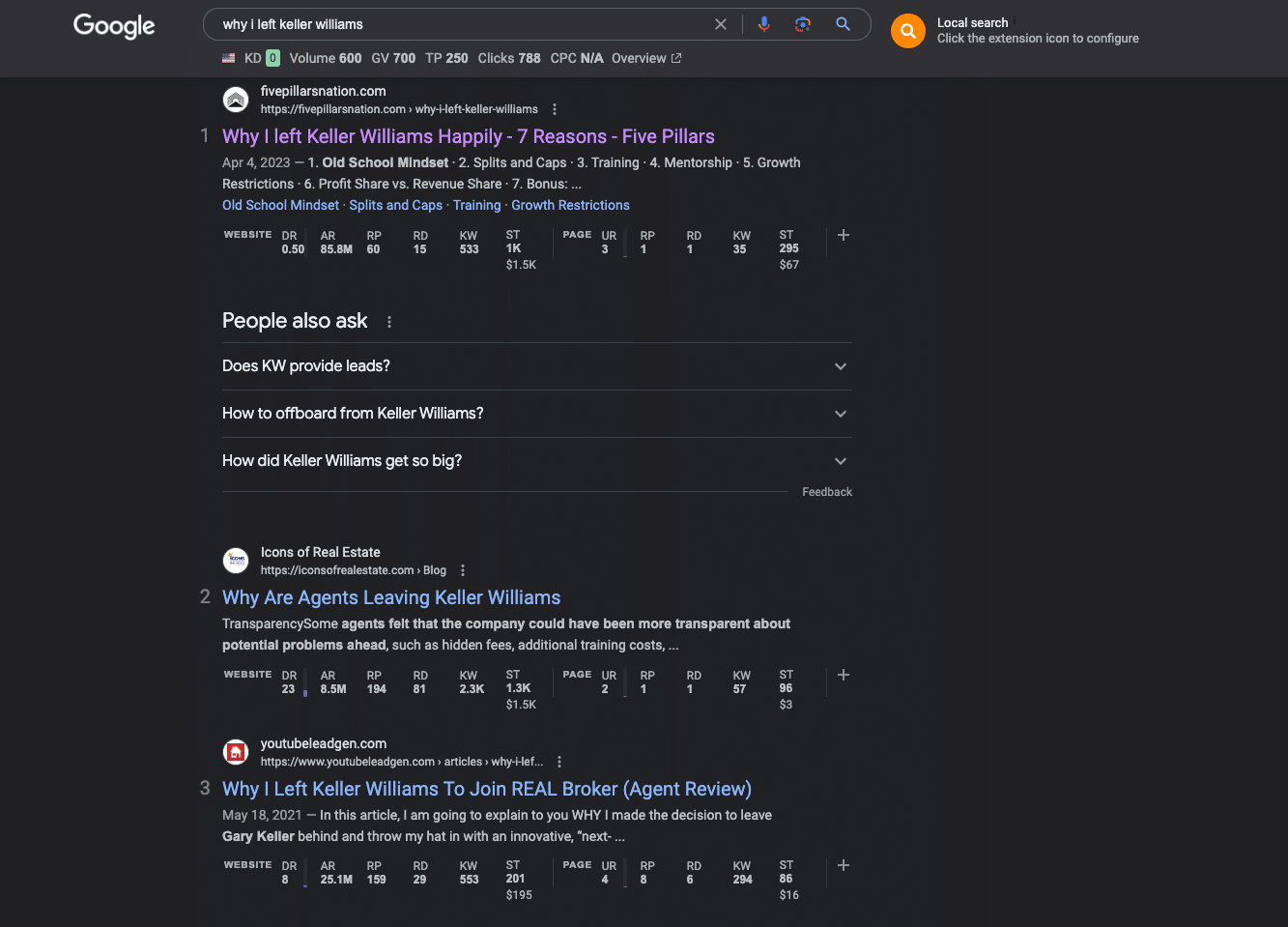
We rank #1 for this keyword and since our article showed as a search result, it will count as 1 impression.
But once I click on the result, Google will track it as a click.
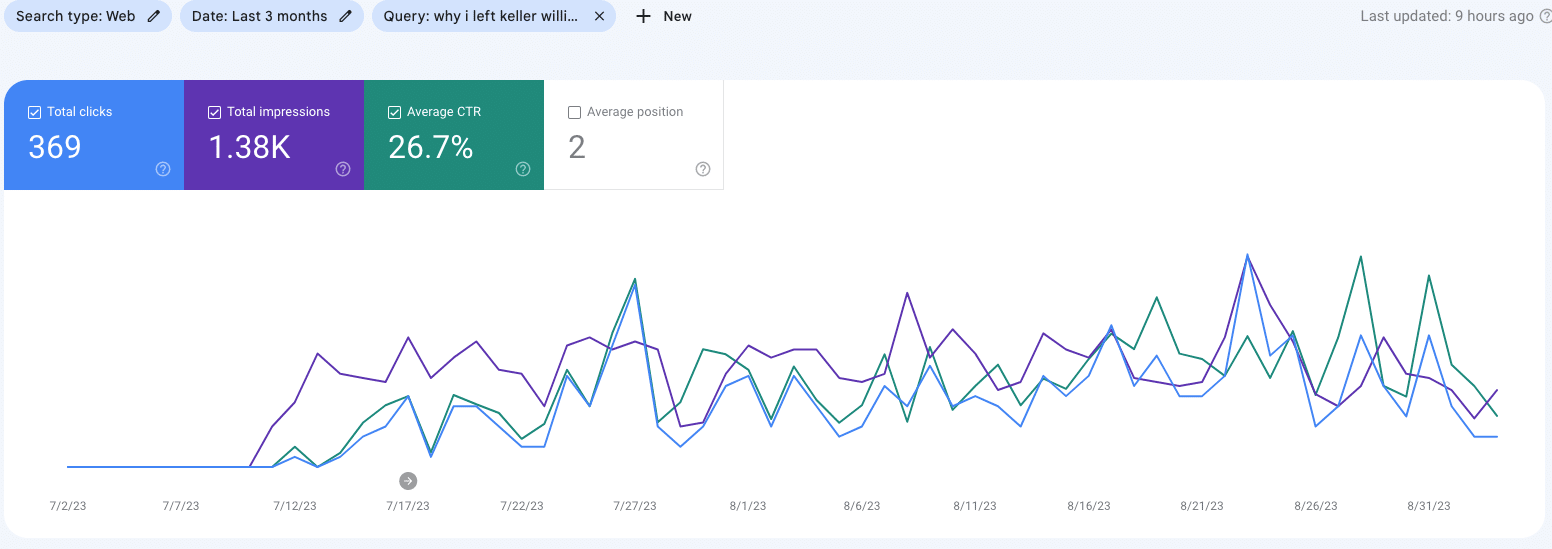
Now, this is much more difficult to track when you’re looking at social media accounts, but the same metrics apply.
Conversion rate
Now you have traffic, but no leads. Driving traffic is easy, but converting that traffic into leads is not. This is not rocket science, so take the number of leads produced and divide it by the traffic to that page.
For example:
You got 5 leads out of 200 visitors to a certain landing page
5/200 = 4% conversion rate
Wondering if you have a low conversion rate? Here is a good standard for your conversion rates:
Low >5%
Average 5-10%
Awesome 10-20%
Phenomenal >20%
Is your conversion rate low? Chances are, your ad isn’t congruent to what info is on your landing page. Or maybe your landing page copy needs work.
But conversion rate isn’t only used for converting traffic into leads. It can also be used to measure:
Leads per Deal = (Leads) / (Closings)
Letters per Lead = (Letters sent) / (Leads)
The list goes on and on…
If you are only converting 1 in every 50 leads you speak to, chances are you are wasting a lot of time. You might be going after the wrong audience, too high in the funnel, or you might suck at sales.
Fortunately for you, all are correctable.
Cost per…
Now that we’ve covered conversion rates, a few more important metrics to track are:
Cost per Click (CPC)
Cost per Lead (CPL)
Cost per Deal (CAC – Customer Acquisition Cost)
Your cost per deal is the driving factor when it comes to marketing.
Now, if you’re paying $1,000 per click, and that one click is converting into a lead, then a closing. Theoretically you’re getting 100% conversion rate $1,000 cost per lead, and $1,000 cost per deal.
This is an unrealistic example but, this seems a little to volatile for me. So, what do I consider a healthy cost per deal?
As someone who was an agent in Fayetteville, NC where the median price was close to $150,000 when I was selling real estate, it would be hard to justify spending $2,000 per deal. That would have been over half of my net commission.
So what I prefer to do is compare marketing costs to referrals. How much would you pay for a referral? 25%? 35%?
If you’re in a market where your average commission is over $30,000, would you feel comfortable spending $10k per deal?
I would spend $10k/day if I could consistently turn it into $30k! Especially considering I used to make as little as $1,500 on a transaction.
Chapter 10: Buyers or Sellers?
Not sure where to focus your real estate marketing? I vote sellers/listings… Here is why:
If you haven’t heard the term “listings are leverage”, it’s true.
Taking a buyer through the buying process requires roughly 2-3 times the amount of work compared to listing a house. You don’t just have the pre-approval process… You also have to show houses, write offers, handle inspections, and make sure your buyers don’t purchase a new car before closing.
Plus, correctly marketing your listings will bring in buyers.
So, focus on finding listings, then use those listings to bring in buyers. It’s a beautiful cycle.
Concluding Real Estate Marketing
By now, you should know real estate marketing concepts better than 99% of other real estate agents.
- What part of the sales funnel you’re targeting
- Whether you want to use demand generation or demand capture
- Which of the core four you’re going to focus on to generate leads
- How to calculate ROI, Cash Conversion Cycle, and conversion rates
I also wrote an in-depth guide on generating real estate leads if this post didn’t answer all your questions.


